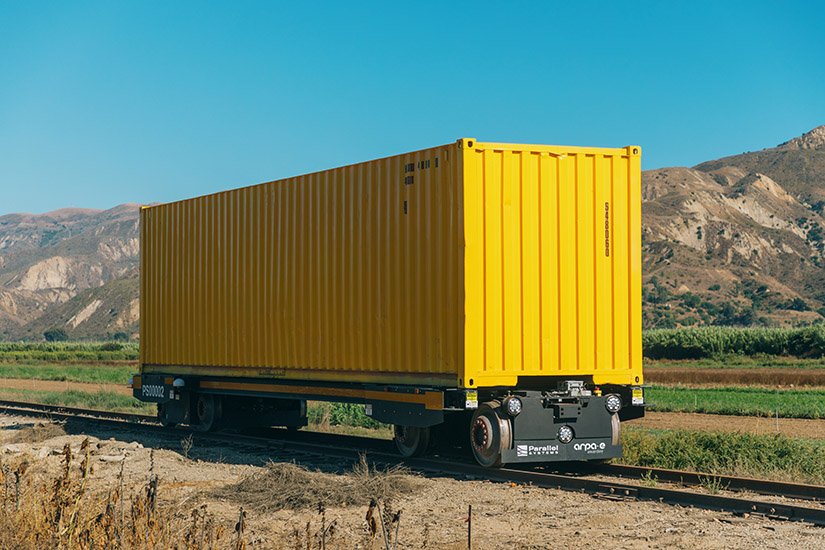NREL's Rail Optimization Software Is Putting Freight Electrification on the Fast Track
Collaboration With Parallel Systems Quantifies Benefits of Autonomous, Battery-Electric Rail Vehicles

For more than a century, American freight trains—responsible for moving a fifth of the nation’s cargo—have run nearly exclusively on carbon-based fuels. But that could change in the coming decade, as railways eye ambitious federal clean-energy goals that call for investment in electric locomotives and infrastructure supporting zero-emission freight movement.
Already, a collaboration between the National Renewable Energy Laboratory (NREL) and Parallel Systems, a Los Angeles-based autonomous electric rail car startup, is poised to put freight decarbonization on the fast track.
Propelling Progress
Parallel Systems’ groundbreaking battery-electric rail cars represent a potential transformation for the rail industry.
Much like the self-driving electric cars already on the roads, Parallel’s rail cars use battery-electric motors, cameras, perception sensors, and advanced braking systems to guide themselves along conventional railways—no onboard engineer or conductor needed. But unlike conventional freight trains, which are propelled nearly exclusively by diesel engines, Parallel Systems’ vehicles combine electric powertrains with a technology called “platooning.” Each self-propelled, battery-electric rail car pushes the one in front of it, reducing aerodynamic drag and lowering the amount of energy needed to power the platoon.
This explainer video demonstrates Parallel Systems' autonomous, battery-electric rail car technology. Text version
And rather than being linked by heavy metal couplers, like traditional freight trains, Parallel’s autonomous rail cars are capable of seamlessly grouping and separating themselves while traveling. That allows them to keep train crossings clear by automatically separating to let vehicles cross their paths. By combining the high freight efficiency of rail with the flexibility and speed normally associated with trucks, the technology is designed to enable faster, cheaper, and lower-emissions movement of goods.
Parallel’s rail cars are currently being field-tested to demonstrate track worthiness at higher speeds and reduced braking distances compared to conventional trains. But before deployment, those rail cars—and corresponding logistics infrastructure—will require powerful software to run autonomous vehicle controls, dispatch cars, manage fleets, and handle terminal operations. And before building out costly physical infrastructure, Parallel can glean significant insights toward optimization of vehicle and network controls, infrastructure placement, and rail yard operations to minimize both operating costs and carbon emissions.
That is where NREL's commercial vehicle expertise comes into play. With funding from the Advanced Research Projects Agency–Energy (ARPA-E) and support from the University of Texas at Austin, NREL researchers are applying the laboratory’s newly released Advanced Locomotive Technology and Rail Infrastructure Optimization System (ALTRIOS) software to help optimize Parallel's operations. ALTRIOS, the world’s first comprehensive and open-source software to optimize rail decarbonization, will quantify how Parallel Systems vehicles reduce energy consumption and greenhouse gas emissions relative to existing locomotives.
“If we want to rapidly decarbonize the transportation sector, we should be moving more freight on rail,” said NREL’s Jason Lustbader, who leads NREL’s advanced vehicles and charging infrastructure research and serves as principal investigator for the project. “But there are a lot of barriers we need to address to decarbonize rail freight movement, from logistics and scheduling to building infrastructure.”
Combined, these two first-in-the-world products—NREL’s rail optimization software and Parallel’s battery-electric rail vehicles—will help shift a portion of the freight currently carried by on-road trucks to rail instead, catalyzing decarbonization across the whole transportation sector.
From Trucks to Trains
But why shift cargo from trucks to rail? Because moving freight on battery-electric rail vehicles can use 75% less energy per mile than moving it on a semitruck. It also frees up highways for easier passenger car travel, reducing traffic congestion. Together, those efficiencies can create enormous fuel savings, helping to significantly reduce transportation-related greenhouse gas emissions.
“That’s why Parallel Systems’ prototype is such an exciting, disruptive concept,” Lustbader said. “It’s also why we designed ALTRIOS: to help overcome the challenges of cost-effectively and quickly transitioning to greener rail operations.”
Importantly, noted Matt Soule, co-founder and chief executive officer of Parallel Systems, diverting freight from on-road trucks to rail vehicles represents an opportunity to accelerate wider transportation decarbonization.
“The rail industry presents one of the most promising avenues for decarbonizing the entire transportation sector,” Soule said. “Our goal at Parallel is to give railroads the tools they need to convert some of the $940 billion U.S. trucking industry to rail.
“The partnership we’ve formed with NREL is helping Parallel Systems’ technology to become more flexible, responsive, and optimized—all benefits that will help railroads to compete more directly with the more energy-intensive modes,” he added.
In pursuit of a clean energy future for all, NREL researchers are bringing cutting-edge data science, advanced analytics, and technological breakthroughs to bear on the freight decarbonization space. Together with leadership from industry partners, the future of freight—and transportation—is looking greener all the time.
Learn more about NREL's sustainable transportation and mobility research and its specific focus on commercial vehicle decarbonization. And sign up for NREL's quarterly transportation and mobility research newsletter, Sustainable Mobility Matters, to stay current on the latest news.
Last Updated May 28, 2025
